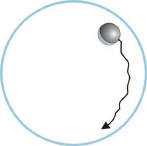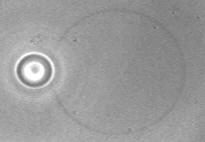Box 1: A latex particle (bright spot) held by an optical trap is brought to a vesicle membrane (dark contour). The particle sticks to the membrane with a characteristic jump (click on the image for a movie)
Shear Viscosity of Membranes
The shear surface viscosity of lipid membranes can be determined by a recently developed method - a microversion of the falling ball viscosimeter (1). The technique makes use of a latex or glass particle attached to a spherical vesicle membrane. Under the action of gravity, the particle sediments towards the bottom of the vesicle while shearing the membrane (see Box 2). The friction coefficient experienced by the latex probe bears the information about the membrane viscosity. One can use not only gravity as a driving force but also thermal energy (diffusion measurements) and radiation pressure force (optical-trap-driven motion) (2).
A typical value for the shear surface viscosity measured on phospholipid vesicles (SOPC) is 3.10-6 dyn.s/cm
.

Box 2: Particle sediments along Spherical vesicle membrane (blue circle)
